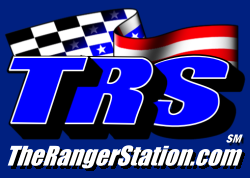INTRODUCTION
If you’re looking for a Ford Ranger for your off-road adventures, there’s plenty to choose from. The key is knowing which ones offer the best components to either be a turnkey off-roader, or a Ranger you can turn into a serious off-roader.
Below is a breakdown of some of the best off-road Ford Rangers from newest to oldest.
2023+ FORD RANGER RAPTOR
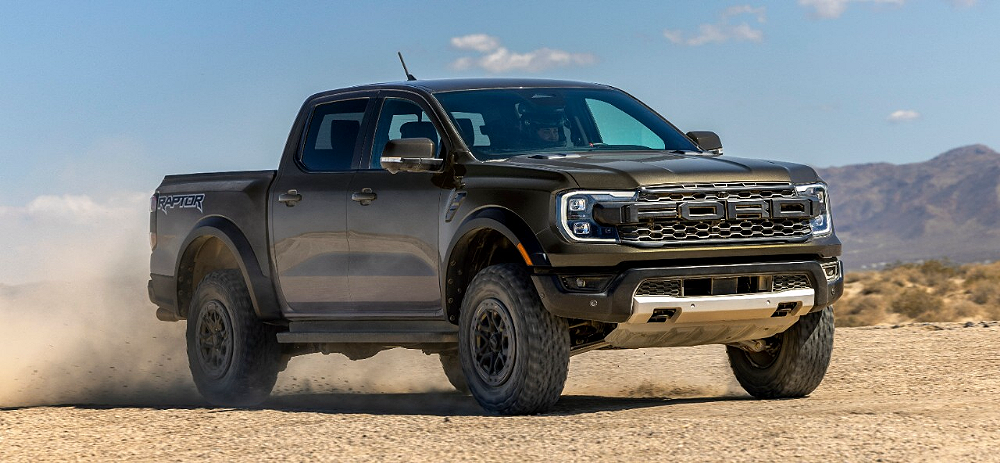
The Ford Raptor has been around since 2010, but for 2024, Ford decided to create a serious off-road option and add a Raptor package to the Ford Ranger platform. The 2024 Ford Ranger Raptor is the most powerful and high-performance, off-road capable Ford Ranger ever produced and is designed and engineered by Ford Performance to take off-road capability to the next level.
Built to take on challenging dunes, Raptor’s long travel suspension, including a Watts link rear suspension and class-exclusive 2.5-inch FOX Live Valve shocks, gives you everything you need to chase down the horizon.
A unique Ford Ranger Raptor 3.0-liter EcoBoost V6 generates 405-horsepower, and 430 pound-feet of torque paired with an advanced four-wheel drive system, a new electronically controlled on-demand two-speed transfer case, and front and rear locking differentials for improved off-road traction.
FORD RANGER RAPTOR FEATURES:
- 3.0L Ecoboost making 405-horsepower and 430 lb-ft. torque
- Active valve exhaust system modes including Quiet, Normal, Sport and Baja settings
- Drive Modes: Normal, Tow/Haul, Sport, Slippery, Off-Road, Rock Crawl, and Baja
- Six overhead upfitter switches mounted in the overhead console
- 360-Degree Camera and Front View Camera
- Zone Lighting to light up the night in remote locations
- Pro Trailer Backup Assist
- Front locking differential
- Rear locking differential
- Forged Aluminum double A-arm suspension with 2.5-inch Fox Live Valve Shocks
- Reinforced front frame rails, front shock towers, rear shock brackets, and suspension mounting points
- Watts-Link rear suspension with trailing arms and 2.5-inch Fox Live Valve Shocks
- P285/70SR17 (32.7×11.2×17) BFGoodrich KO3 all-terrain tires
- 17-inch wheels that can be mounted to optional beadlock capable wheels with available bead locks
- Trail Control
- Front & rear tow hooks
- 10.7-inches of ground clearance (1.4-inches more than your regular Ranger)
- 1.4-inches and 2.7-inches more suspension travel front and rear than a stock Ranger
- 33.0° approach angle
- 26.4° departure angle
- 24.2° breakover angle
- Base Price $57,065 (as tested $59,900)
The Ford Ranger Raptor is a serious off-road truck offering 135 more horsepower than the Ford Ranger Tremor or Ford Ranger FX4. At $57,000 it’s a good $10,000 more than a Ford Ranger Tremor and probably $13,000 more than a Ford Ranger FX4. You can’t deny it’s off-road performance and capability.
WHO SHOULD BUY IT
This Ranger is perfect for the person that wants a high-performance off-road truck without having to purchase and modify one.
Check out the 2024 Ford Ranger Raptor.
2021-2023 FORD RANGER TREMOR
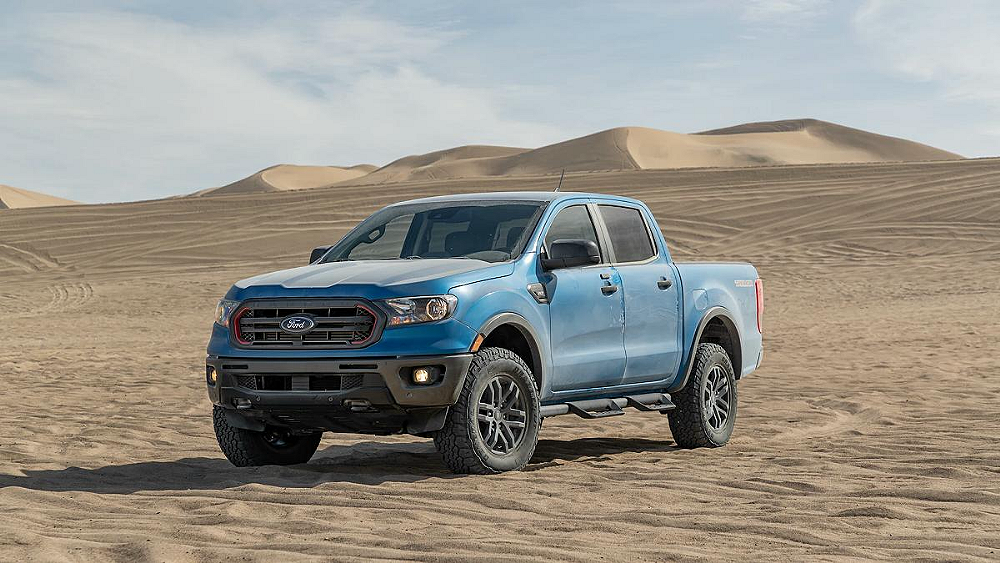
From 2021-2023 Ford offered a ‘Tremor’ off-road package on the Ford Ranger. This is supposed to be a step up from the FX4 off-road package that has been offered since the Ford Ranger returned to production in 2019.
THE TREMOR PACKAGE INCLUDES:
- 2.3L EcoBoost making 270-horsepower
- Off-road tuned suspension
- FOX 2.0 monotube dampers with rear piggyback reservoirs
- Rear multi-leaf springs
- 265/70/17 (31.6×10.4×17) General Grabber A/TX all-terrain off-road tires
- 6-switch auxiliary power pack (upfitter switches)
- Black exposed steel bash plate and underbody skid plates
- Terrain Management System
- Trail Control
- 4×4 electronic rear locking differential
- Off-road screen
- 9.7-inches of ground clearance
- 30.9° approach angle
- 25.5° departure angle
- 24.2° breakover angle
- Hoop steps
- 17″ Magnetic-painted aluminum wheels
- Two rear tow hooks (n/a with Tow Package)
- Unique grille with Magnetic-painted surround, black bars and red nostril accents
- Magnetic-painted wheel-lip moldings with 1-inch wider offset
- Magnetic-painted bumpers
- Ebony seats with Miko suede inserts and TREMOR stitched into the seat backs
- Black interior accents
- All-weather floor mats
TRAIL CONTROL
Designed for low-traction, off-road conditions, Trail Control 1,2 acts as a low-speed cruise control, maintaining your selected speed from 1 to 20 mph. It manages acceleration and braking – sending power and braking to each individual wheel as needed – so you can keep your focus on steering while going uphill, downhill, or over rugged terrain. Trail Control can be engaged while Ranger is in 2H, 4H or 4L, and in combination with any of the 4 Terrain Management System modes, to help provide maximum traction when you venture beyond the pavement. Ford’s new Trail Control system is basically slow speed cruise control for off-roading.
TERRAIN MANAGEMENT SYSTEM
Ranger features the only Terrain Management System1 in the class that works in both 4H and 4L, offering you seamless shift-on-the-fly confidence over all sorts of surfaces. Just tap the “TM” button to select any of the 4 modes. The system automatically calibrates engine responsiveness, transmission gearing, and vehicle control systems to provide the optimum traction, drivability and performance.
Normal Mode is ideal for everyday driving on wet or dry paved roads.
Grass/Gravel/Snow Mode lets the transmission deliver earlier upshifts and less aggressive engine torque distribution, limiting wheel slip to help improve traction on tricky terrain.
Mud/Ruts Mode allows powertrain torque to be a bit more aggressive, limiting transmission upshifts and letting the wheels spin to get you through the thick stuff.
Sand Mode uses more aggressive throttle progression and holds gears longer to help transfer optimized torque to the wheels. They can spin aggressively to maintain momentum and keep the fun going.
DIFFERENCE BETWEEN THE FX4 AND THE TREMOR
- The Tremor package is $4,290
- The FX4 package is $1,295
- The Tremor is 0.8-inches taller
- The Tremor has a 2.2° better approach angle
- The Tremor has a 0.1° worse departure angle
- The Tremor has a 2.7° better breakover angle
- The Tremor has rear tow hooks
- The Tremor has FOX 2.0 monotube dampers with rear piggyback reservoirs
- The Tremor has 32-inch General Grabber A/TX all-terrain off-road tires (2-inches taller than FX4)
- The Tremor has a 6-switch auxiliary power pack (upfitter switches)
Compared to the base Ranger, the Ford Ranger Tremor is raised 20mm (approximately 0.8-inches) at the front and rear. That’s not much considering that the 1987-1989 Ford Ranger STX had a factory suspension lift that was 1.5-inches taller than the base Ranger.
The Tremor package will set you back $4,290 and can be optioned on mid-XLT and high-Lariat 2021 Ford Ranger trucks in the SuperCrew 4×4 configuration. That’s quite a bit more than the Ford Ranger FX4 package that’s about $1,295.
If you foresee yourself wanting to add a suspension lift and larger tires than you would be better off going with an FX4 model. When you look for suspension lifts or leveling kits for the 2021-2023 Ford Ranger 4×4 you will see a note that says, ‘Does NOT work on models equipped with Tremor package.’
The hoop steps will get in the way if you do any actual off-roading and you’ll probably end up removing them if you do.
The 6-switch auxiliary power pack is a great feature for adding auxiliary accessories such as lighting.
WHO SHOULD BUY IT
The Ford Ranger Tremor is a good option for those that want a capable off-road or adventure vehicle, but don’t want to make any suspension modifications.
Check out the 2021Ford Ranger Tremor
2019+ FORD RANGER FX4
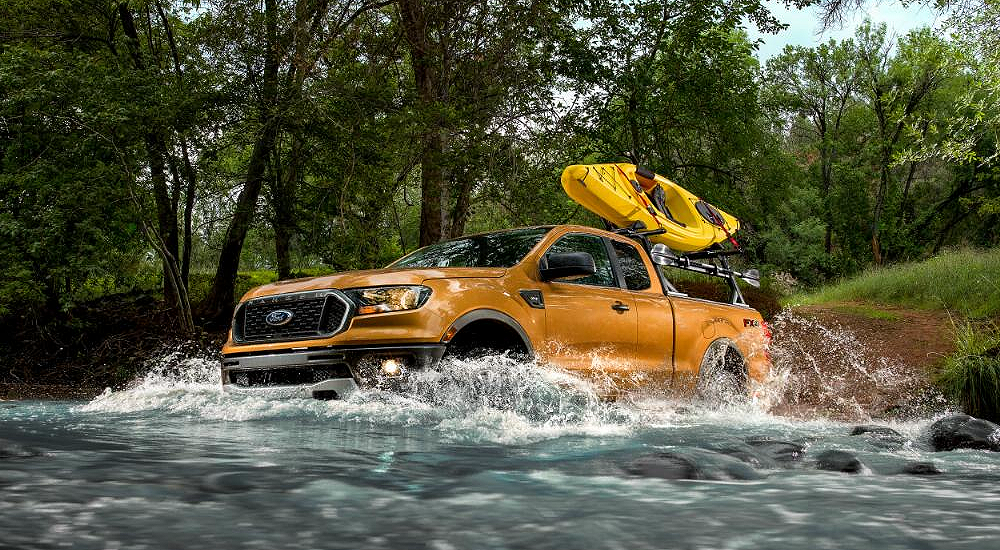
When the Ford Ranger returned in 2019, it came with an FX4 option that makes it quite a capable off-road truck. The FX4 package adds about $1,090 to the price of the truck.
THE FX4 OPTIONS INCLUDES:
- 2.3L EcoBoost making 270-horsepower
- Terrain Management System
- Trail Control
- Off-road tuned suspension
- Electronic-locking rear differential
- Skid plates for fuel tank, transfer case and steering gear
- Front steel tow hooks
- Off-road display in the instrument cluster screen to help increase your off-road confidence
- 265/65/17 (30.40×10.40×17) Hankook Dynapro ATM tires
- 8.9-inches of ground clearance
- 28.7° approach angle
- 25.4° departure angle
- 21.5° breakover angle
TRAIL CONTROL
Designed for low-traction, off-road conditions, Trail Control 1,2 acts as a low-speed cruise control, maintaining your selected speed from 1 to 20 mph. It manages acceleration and braking – sending power and braking to each individual wheel as needed – so you can keep your focus on steering while going uphill, downhill, or over rugged terrain. Trail Control can be engaged while Ranger is in 2H, 4H or 4L, and in combination with any of the 4 Terrain Management System modes, to help provide maximum traction when you venture beyond the pavement. Ford’s new Trail Control system is basically slow speed cruise control for off-roading.
TERRAIN MANAGEMENT SYSTEM
Ranger features the only Terrain Management System1 in the class that works in both 4H and 4L, offering you seamless shift-on-the-fly confidence over all sorts of surfaces. Just tap the “TM” button to select any of the 4 modes. The system automatically calibrates engine responsiveness, transmission gearing, and vehicle control systems to provide the optimum traction, drivability and performance.
Normal Mode is ideal for everyday driving on wet or dry paved roads.
Grass/Gravel/Snow Mode lets the transmission deliver earlier upshifts and less aggressive engine torque distribution, limiting wheel slip to help improve traction on tricky terrain.
Mud/Ruts Mode allows powertrain torque to be a bit more aggressive, limiting transmission upshifts and letting the wheels spin to get you through the thick stuff.
Sand Mode uses more aggressive throttle progression and holds gears longer to help transfer optimized torque to the wheels. They can spin aggressively to maintain momentum and keep the fun going.
WHO SHOULD BUY IT
Anyone serious about off-roading and adventure travel. Equipped with skid plates, rear locker, Terrain Management and Trail Control, the Ford Ranger FX4 is the perfect platform to build a modern off-road and adventure vehicle on.
2002 FORD RANGER FX4 & 2003-2007 FORD RANGER FX4 LEVEL II
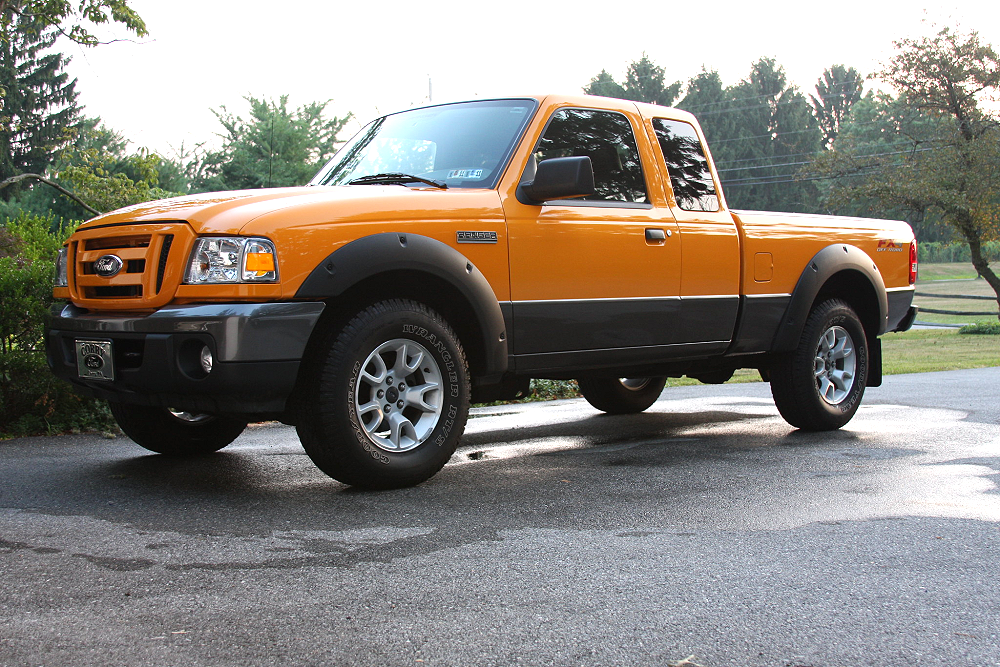
New for 2002 was an FX4 Package on the Ford Ranger. This was Ford’s first serious attempt at building an offroad capable Ford Ranger. The truck came with a 31-spline 8.8-inch rear axle (stock is 28-spline), 4.10 gears, a Torsen limited slip rear differential, 31×10.50×15 BF Goodrich All-Terrain tires, skid plates, tow hooks, and a manual transfer case.
Only the 2002 FX4, and 2003-2007 FX4 Level II’s received the Torsen limited slip rear differential and 31-spline rear axle. The other 2003-2007 FX4 models used a 28-spline 8.8-inch rear axle and the standard Ford Trac-Lok limited slip. In 2008-2009 the Torsen limited slip rear differential was optional.
Another nice feature of these Rangers over earlier models is that the 4.0 SOHC engine produced 207-horsepower, whereas the 1990-2000 4.0L OHV engines only made 160-horsepower. They also came with a 5R55E 5-speed automatic instead of the earlier 4R55E 4-speed automatic or a M5OD-R1 5-speed heavy duty manual transmission.
These trucks are pretty capable as they are and can be easily modified to accept a 33-inch tire. They’re also a great foundation to build on.
A 5-inch Rough Country suspension lit, 33-inch Cooper Rugged Trek tires, and a locker would really take this Ranger to the next level.
Standard Features:
- 4.0L SOHC V6 making 207-horsepower
- Bilstein Shocks
- Skid Plates
- 31-spline Ford 8.8-inch rear axle
- Torsen Limited Slip Differential
- 4.10 Gears
- 31×10.50×15 BF Goodrich All Terrain Tires
- 15-inch Alcoa wheels
- Tow hooks
- Manual transfer case
- Sport bucket seats
1995-1997 FORD RANGER 4X4
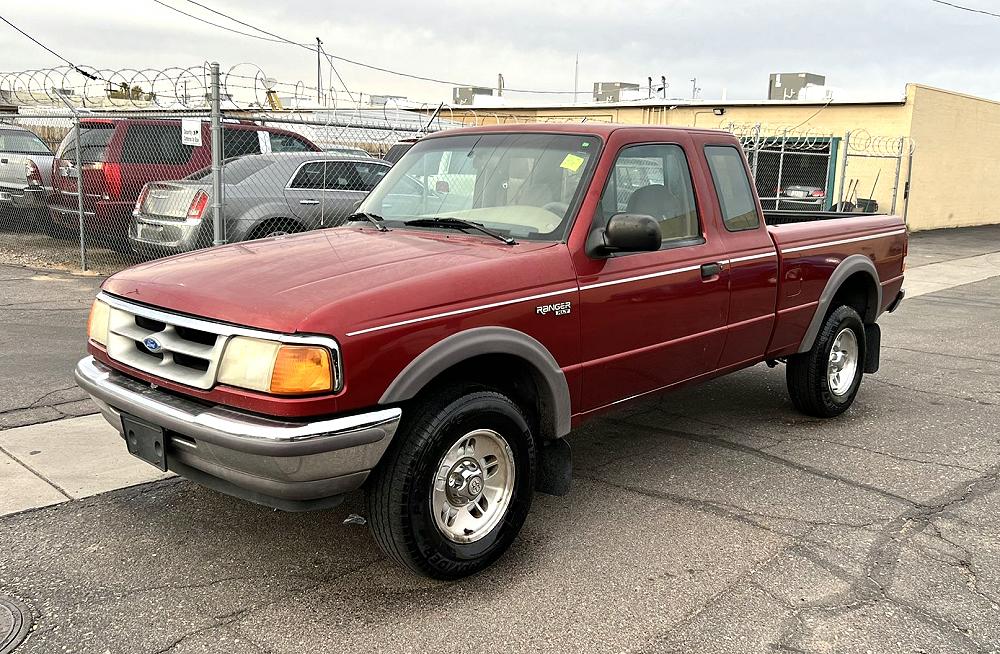
In 1995 the brakes on the Ford Ranger were upgraded to a dual piston brake caliper, and the automatic transmission was upgraded from the A4LD 4-speed to a stronger 4R55E 4-speed automatic transmission. These Rangers also came with a M5OD-R1 5-speed manual transmission which is also a reliable transmission.
Ford also offered this Ranger with a 2.3L 4-cylinder making 100-horsepower in 1995 and 112-horsepower from 1996-1997 and a 3.0L V6 making 147-horsepower. I would look for a Ranger with the 4.0L V6 making 160-horsepower.
A 1995-1997 Ford Ranger 4×4 with the 4.0L V6 and 4R55E transmission, Dana 35 TTB front axle and Ford 8.8-inch rear axle is a great platform to build an off-road Ranger on.
1990-1994 FORD RANGER 4X4 W/MANUAL
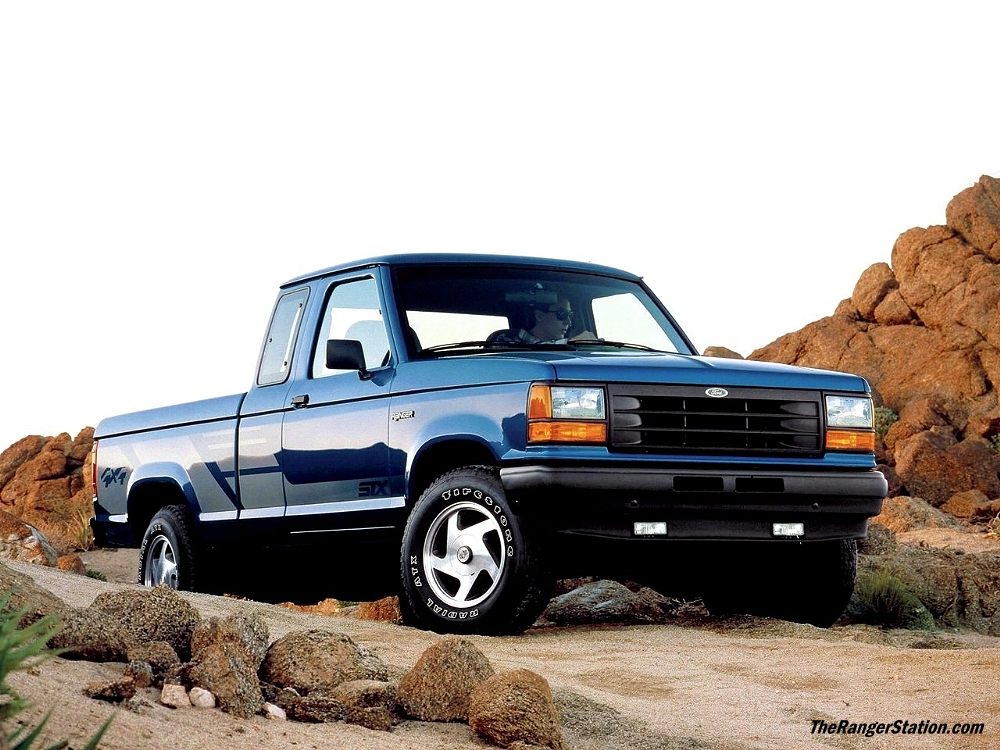
In 1990 Ford introduced the 4.0L V6 that made 160-horsepower, a Dana 35 TTB front axle to replace the smaller Dana 28 TTB axle, and a 28-spline Ford 8.8-inch rear axle on the 4.0L equipped models to replace the smaller Ford 7.5-inch rear axle. These Rangers came with a M5OD-R1 5-speed manual transmission and are a good platform to build on if you’re looking to build an off-roader with a manual transmission.
Ford offered a 2.3L 4-cylinder (100-horsepower) and 3.0L V6 (145-horsepower) during this time period. I would look for a Ranger with the 4.0L V6 (160-horsepower).
1989 FORD RANGER STX 4X4 SPORT RIDER W/MANUAL
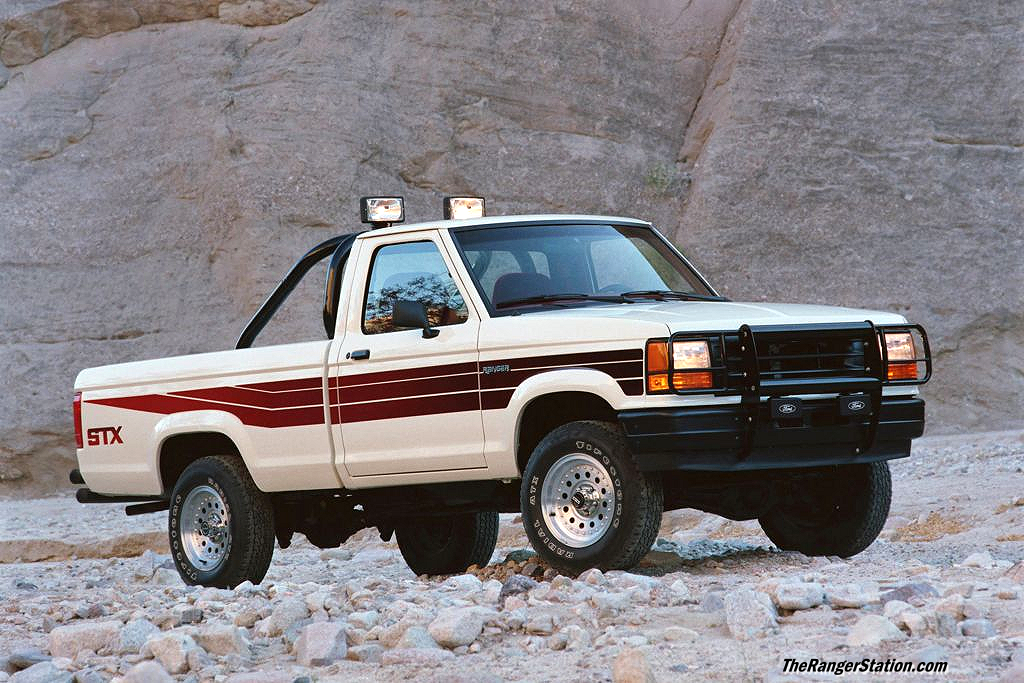
In 1989 Ford offered the Ranger with a STX ‘Sport Rider’ package (instead of ‘High Rider’)(See below). This STX came with a 1.5-inch factory suspension lift, grill guard, roll bar, off-road lights, and tube rear step bumper. The Ranger came standard with a Mazda M50D-R1 5-speed manual transmission and an optional A4LD automatic transmission which I would avoid. Power comes from a fuel-injected 2.9L V6 engine that makes 140-horsepower. It only comes with a Dana 28 TTB and Ford 7.5-inch rear axle but has 3.73 gears and a limited slip.
These were cool looking trucks, and it’s surprising that Ford sold a Ranger with a factory lift kit. This wasn’t just a 1.5-inch taller coil spring or spacer. Ford actually used a taller coil spring in the front along with different axle mounting brackets to lower the axle pivot points just like you do with an aftermarket suspension lift. Aftermarket suspension companies stated that you couldn’t use their kits on these STX models. You could, but a 4-inch lift would only give you a 2.5-inch lift over the factory ride height since the STX was 1.5-inches taller than the non-STX models.
The 1989 Ford Rangers came with a P195/75Rx15 (26.5″x7.7″x15″) tire, but the STX came with a P215/75Rx15 (27.7″x8.5″x15″) tire. This year non-STX Ford Ranger will fit a 30×9.50×15 tires with a 2-inch lift and a little fender trimming, so the STX is pretty close to that. A 1-inch spacer under the coil on these trucks would basically give it a 2.5-inch lift over stock, so a 30×9.50×15 tire should fit.
Typically, you can lift a 1989 Ford Ranger 4×4 1.5-inches before you need new drop brackets to lower the axles pivot points. When you get around the 2-inch lift point you’ll have problems getting the wheels aligned. Trying to install a 4-inch lift coil would be like trying to add a 2.5-inch lift coil. You probably wouldn’t be able to align it. James Duff offers a 3-inch lift for the Ford Ranger. A set of their coils would be equivalent to adding a 1.5-inch lift coil and should be able to be aligned.
These Rangers have become pretty rare, so if I found one, I’d try to keep it the fun Ford Ranger 4×4 that it was intended to be, retain the factory suspension, and limit the tire size to 31-inches.
To learn more, check out: 1987-1988 Ford Ranger ‘High Rider’ STX & 1989 ‘Sport Rider’ STX
1987-1988 FORD RANGER STX 4X4 HIGH RIDER W/MANUAL
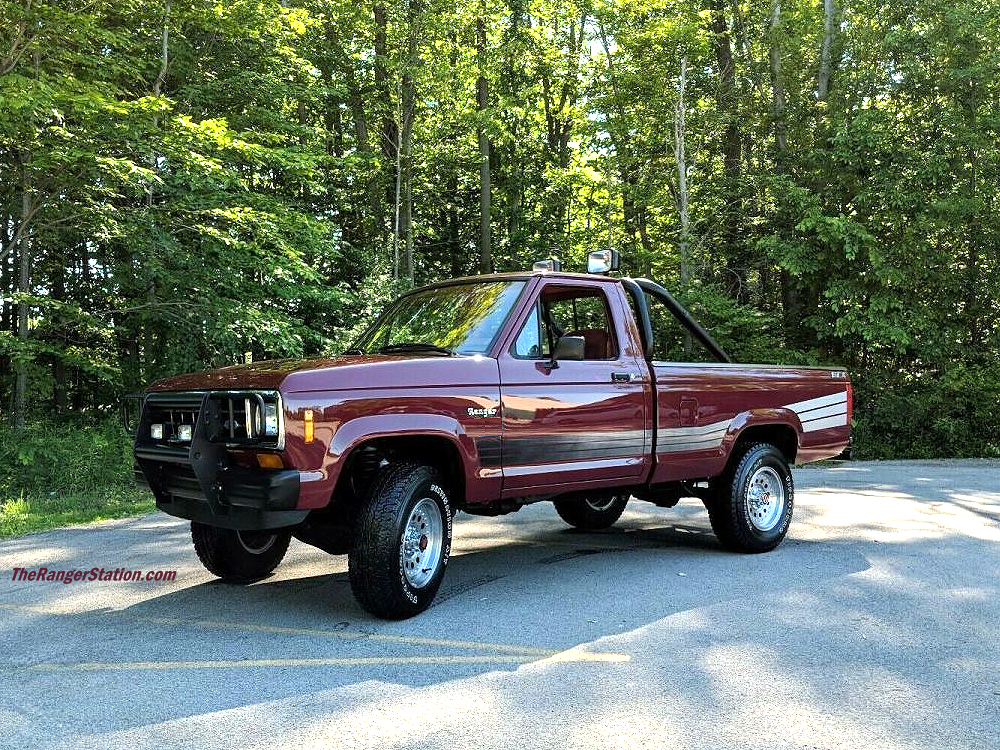
In 1987 & 1988 Ford offered the Ranger with a STX ‘High Rider’ package. This STX came with a 1.5-inch factory suspension lift, grill guard, rear tube bumper, roll bar and off-road lights. The Ranger came standard with a Mazda M50D-R1 5-speed manual transmission and an optional A4LD automatic transmission which I would avoid. Power comes from a fuel-injected 2.9L V6 engine that makes 140-horsepower. It only comes with a Dana 28 TTB and Ford 7.5-inch rear axle but has 3.73 gears and a limited slip.
These were cool looking trucks, and it’s surprising that Ford sold a Ranger with a factory lift kit. This wasn’t just a 1.5-inch taller coil spring or spacer. Ford actually used a taller coil spring in the front along with different axle mounting brackets to lower the axle pivot points just like you do with an aftermarket suspension lift. Aftermarket suspension companies stated that you couldn’t use their kits on these STX models. You could, but a 4-inch lift would only give you a 2.5-inch lift over the factory ride height since the STX was 1.5-inches taller than the non-STX models.
The 1987-1988 Ford Rangers came with a P195/75Rx15 (26.5″x7.7″x15″) tire, but the STX came with a P215/75Rx15 (27.7″x8.5″x15″) tire. This year non-STX Ford Ranger will fit a 30×9.50×15 tires with a 2-inch lift and a little fender trimming, so the STX is pretty close to that. A 1-inch spacer under the coil on these trucks would basically give it a 2.5-inch lift over stock, so a 30×9.50×15 tire should fit.
Typically, you can lift a 1983-1992 Ford Ranger 4×4 1.5-inches before you need new drop brackets to lower the axles pivot points. When you get around the 2-inch lift point you’ll have problems getting the wheels aligned. Trying to install a 4-inch lift coil would be like trying to add a 2.5-inch lift coil. You probably wouldn’t be able to align it. James Duff offers a 3-inch lift for the Ford Ranger. A set of their coils would be equivalent to adding a 1.5-inch lift coil and should be able to be aligned.
These Rangers have become pretty rare, so if I found one, I’d try to keep it the fun Ford Ranger 4×4 that it was intended to be, retain the factory suspension, and limit the tire size to 31-inches.
Every once in a while, one of these trucks does show up for sale as seen here: 1988 Ford Ranger STX High Rider 4×4 Garage Find
To learn more, check out: 1987-1988 Ford Ranger ‘High Rider’ STX & ’89 ‘Sport Rider’ STX
1983-1984 FORD RANGER 4X4 SHORTBED
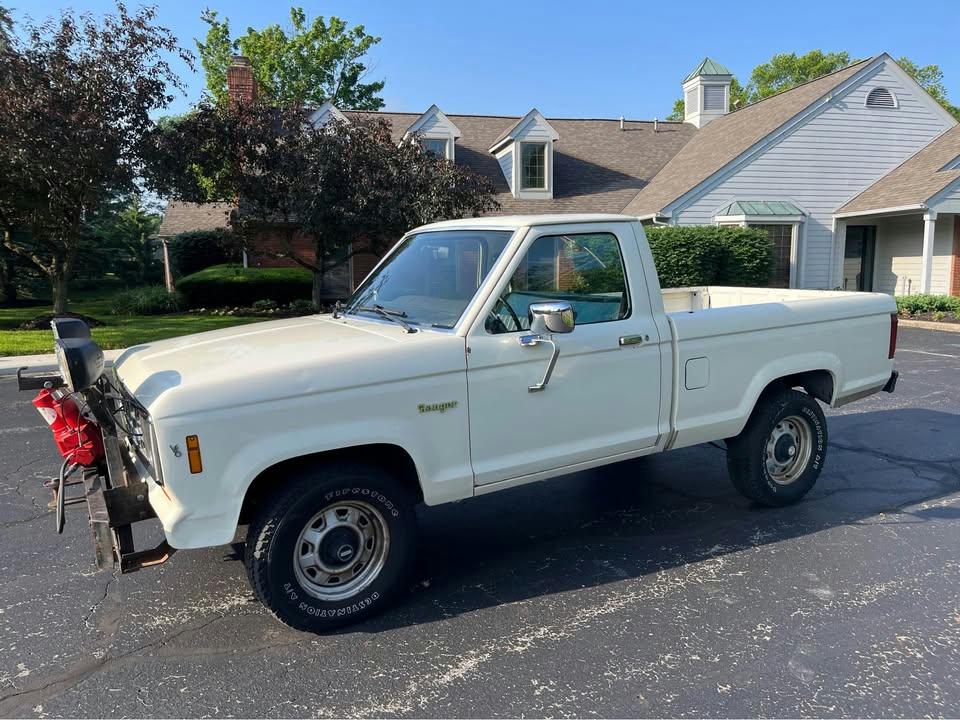
This one probably comes as a surprise to people. The 1983-1984 Ford Ranger 4×4 could be purchased as a short bed and came with a 2.8L V6 engine making 115-horsepower and either a Toyo Koygo 4-speed or 5-speed transmission or a C5 automatic.
The C5 automatic transmission is essentially a C4 medium duty transmission, but with a lock-up clutch in the torque converter to improve highway fuel economy. The C5 is a good transmission, and was the only automatic used in a 4×4 Ford Ranger that wasn’t computer controlled. In 1985 the Ford Ranger switched to the A4LD automatic transmission which was based on the Ford C3 light duty transmission. These transmissions are not very reliable in an off-road vehicle.
The 2.8L V6 is a very reliable engine that uses a gear drive instead of a timing chain (timing chains stretch and wear out) and a carburetor. Its downfall is that it uses a TFI ignition module. If your 2.8L won’t start, it’s probably the TFI module mounted to the side of the distributor. The good news is that a lot of people replace the TFI and ECM with a Duraspark ignition system.
I like the short bed because it’s 107.9″ wheelbase makes it very agile on the trail, but they were a lot less common than the long bed Rangers.
One of these Rangers on 31-inch tires could be a lot of cheap fun. I actually saw someone off-roading one of these with a 2-inch lift, cut fenders to allow 31-inch tires, and a welded rear differential making it a locker, and the little truck went everywhere!
WHAT TO AVOID
Ok, we talked about what Rangers are best for off-road and why. What Rangers should you avoid?
Dana 28 Front Axle
The 1983-1989 Ford Ranger came with a Dana 28 TTB front axle with a small ring gear, axle shafts, and u-joints. These axles are better suited for tires up to 31-inches tall. A 33-inch tire will put a strain on these axles, and it may fail under harsh off-roading. I’m not aware of any companies making ring gears or differentials for these axles, but you can still find some manual locking hubs and replacement axle shafts. If you have a Ranger with one of these axles, you may want to replace it with a Dana 35 TTB.
See: 1983-1997 Ford Ranger 4×4 Front Axles
1993-1997 Ford Ranger 4×4
The 1993-1997 Ford Ranger 4×4 with a 4-cylinder engine was equipped with a Dana 35 axle that has Dana 28 components, so it’s not a true Dana 35 axle.
See: 1983-1997 Ford Ranger 4×4 Front Axles
A4LD Transmission
The 1985-1994 Ford Ranger came with an A4LD automatic transmission. These are based on the C3 automatic light duty transmission and are known to fail in off-road applications. The biggest killer of these transmissions is heat.
TK4 & TK5 Manual Transmissions
The Toyo Koygo 4-speed and 5-speed transmissions were used from 1983-1987. The only problem I’ve experienced with them has been the shifter. There is a nylon ball at the base of the shift handle thar wears out and falls apart. You may find yourself having to find a replacement shifter.
Core Shifters TK4 & TK5 Shifters
